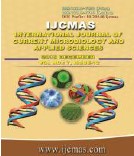


 National Academy of Agricultural Sciences (NAAS)
National Academy of Agricultural Sciences (NAAS)

|
PRINT ISSN : 2319-7692
Online ISSN : 2319-7706 Issues : 12 per year Publisher : Excellent Publishers Email : editorijcmas@gmail.com / submit@ijcmas.com Editor-in-chief: Dr.M.Prakash Index Copernicus ICV 2018: 95.39 NAAS RATING 2020: 5.38 |
Under Indian context, the prosperity of a country depends upon the welfare of farmers and majority of the Indian farming communities follow traditional norms of agriculture which support their livelihood. Farming in India is characterized by small, marginal, and fragmented land holdings (about 86 per cent) and is highly depended on monsoon showers. Operating small holdings is often unviable and in this situation, farming is not a profitable business or enterprise. In the context of Bihar, major challenges and issues in agriculture are the occurrence of flood, drought and hail storm as well as high cost and meager availability of quality seeds, fertilizers, irrigation, lack of marketing facility, low storage, and processing facilities etc. Therefore, there is an urgent need of transformation in agriculture production combined with integrated farming system (IFS) approaches that involves crop cultivation, dairy, poultry, fishery, mushroom cultivation, agro-forestry, piggery, beekeeping, vegetable and fruit production, use of renewable energy source (i.e. Solar energy, Biogas) etc. For doubling of the farmer's income few vital strategies need to be adopted considering the basic requirements of the farmers. These strategies might be massive investments in agricultural research and development, adoption of Good Agricultural Practices (GAP), conservation agriculture technology, implementation of farmers friendly policies, judicious use of available resources and inputs, along with improved market and transportation facility, minimum support price (MSP) reform, supported by adequate and timely availability of bank credits. It has been reported that a rise in MSP will raise farmer income by 13-26 per cent. Smart farming and credit supporting smart farming are other possible strategies in doubling farmer’s income. When we talk about diversification, it mostly deals with high value crops. Economic and socio-ecological access to sustainable production could be only ensured by adopting farming system approach.
 |
 |
 |
 |
 |